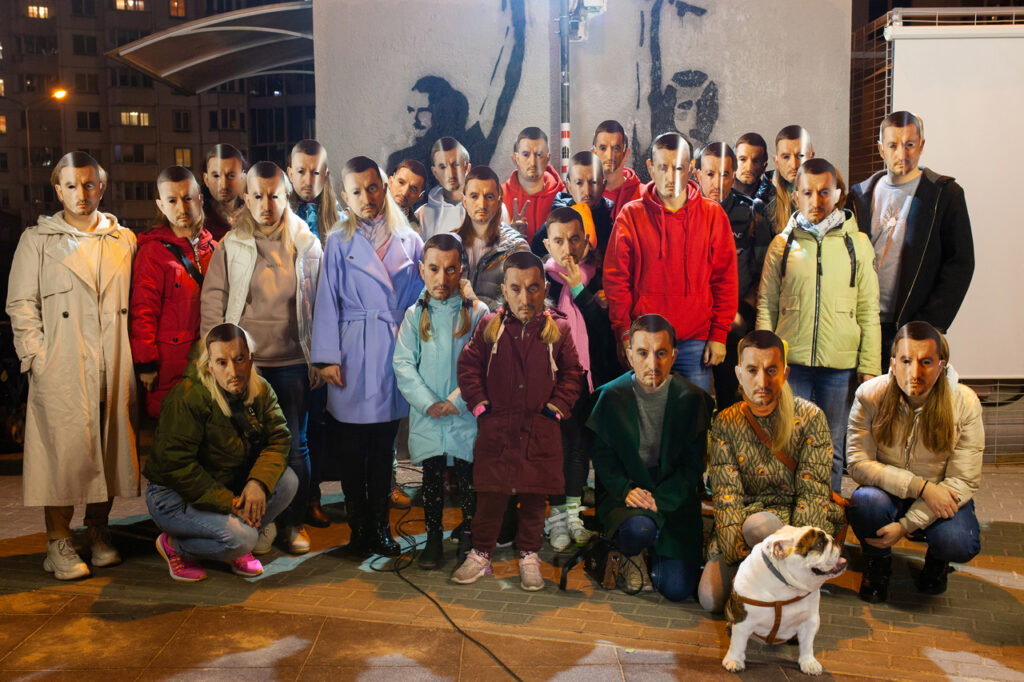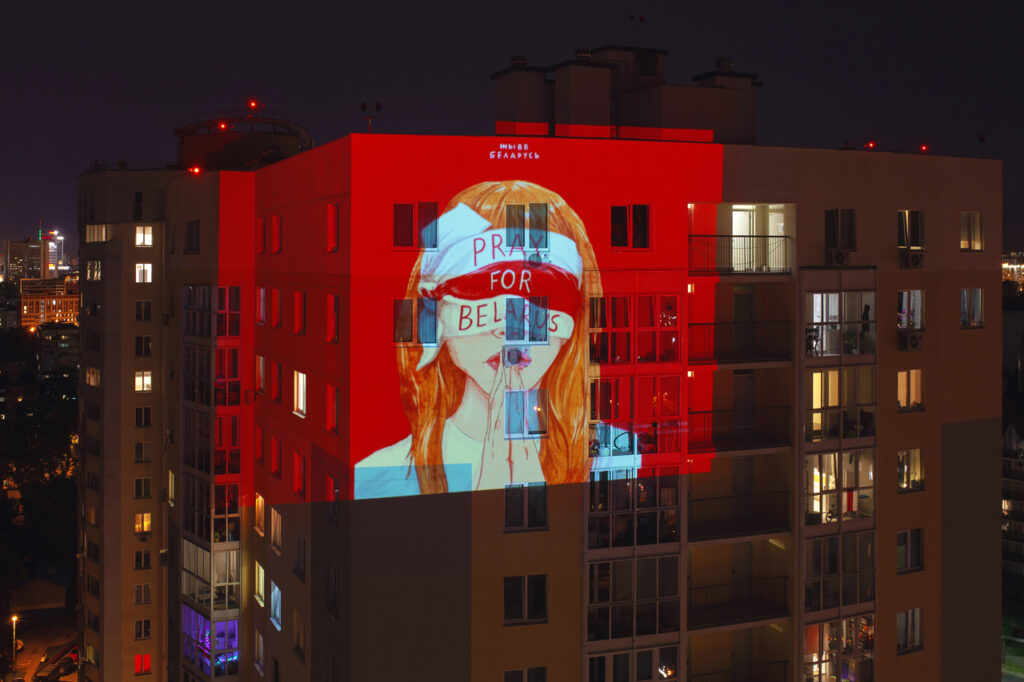A PARTISAN WHO CARES – BELARUSIAN PROTESTS A YEAR LATER
12/29/2021
2020 was a year that would go down in history for Belarus, widely known as “the last dictatorship of Europe.” The rallies against the rigged elections in Belarus were record breaking not only because of their scale in which the protestors were determined to overthrow the regime, but also the creative strategies employed to express dissent. However, after the crackdown and harsh repressions resulting in 967 political prisoners, the protesters were forced to adopt new formats. These moments of dissent had to become invisible in order to not be detected. For Belarusian partisans, however, such strategies are far from being new.

Irony was one of the invisible strategies that became a distinctive feature of the protests of 2020. They began as a response to Lukashenko’s disregard for the pandemic, electoral fraud, and police violence against the civilians. Festively dressed citizens took to the streets – many equipped with posters, singing songs, playing music and holding the pre-Soviet national white-red-white flags – a historical symbol that Lukashenko reverted back to the Soviet flag in the 1990s. Some carried handmade installations – a cardboard coffin meant for the dictator and the dictator himself who was rendered as a huge cockroach, a reference to Lukashenko’s nickname he had earned for his inconsistent decisions and ignorant remarks. Almost from the beginning, the protests were peaceful and resembled a big carnival rather than a tempestuous mob.
Another prominent strategy used in the women’s marches was the practice of holding flowers and forming human “solidarity chains.” Some women wore wedding dresses, national shirts with embroidered elements (”vyshavanka”) or other holiday clothes that had white-red-white color combinations.
The phenomenon quickly attracted the attention of global media outlets that used it to “brand” the Belarusian revolution. On August 1, 2020 an image of “a flower girl” appeared on the cover of The Guardian with the heading, “Flower power: the women driving Belarus’s movement for change”. A similar message was later launched by “The New York Times” that published an article “In Belarus, Women Led the Protests and Shattered Stereotypes”.
Nevertheless, the festive mood had to change as the police’s aggression surged. They used stun grenades, rubber bullets, and water cannons and initiated massive waves of repressions – the arrestees were given sentences for actions that could hardly be categorized as civil dissent. The color combination of white-red-white began to be regarded as an extremist symbol and everyone who in any way bore this trio was detained.
Among some most absurd incidents, one can recall the episode involving a 75-years-old retiree arrested and fined for eating a white-red-white marshmallow, or a criminal case launched against five Belarusians for writing “We will not forget!” on the road near the place where a protestor, Alexander Tarainovskyi, was killed by police on August 10, 2020.
Realizing that massive marches were no longer safe and could lead to detention, the Belarusians had to change the way they expressed dissent. The first step concerned the protests’ scale – instead of taking to wide avenues, people started gathering locally and holding backyard tea parties and concerts to show each other solidarity and support. However, in late 2020 autumn, even these harmless events had to be rethought. On November 15, 2020, after a brutal police raid, around 450 people were arrested – many at the so-called “Square of Changes” where the artist Roman Bondarenko had been beaten to death by plainclothes policemen a few days before. It became obvious – no city location could be a safe place for any kind of public activity, whatever its goal was. Forms of resistance had to be reconsidered again.
Nevertheless, remaining active in the difficult conditions of the dictatorial regime was not something totally new for the Belarusian nation, whose Soviet past in the period of WWII is widely known for being connected with the forest partisan movement.
Conceptualizing the heroic figure of the Soviet Belarusian partisan and its application to the broader political, metaphysical, and historical context was proposed in 1997 by the artist Igor Tishin. In his project “Light Partisan Movement,” Igor showed a different side of the partisan – as someone who “gave up open resistance to arbitrary official cultural policy”. 23 years later the metaphor was reconsidered by the philosopher and critic Maxim Zhbankov, who saw it as well-fitting to not only the consequences of the 2020 protests but also the very strategy of the nation’s existence in the times of lawlessness. Thanks to the ability to “escape from the controlling eye and avoid repressive mechanisms that the Belarusian nation managed to exist rather autonomously for decades,” in Zhbankov’s opinion. “Effective counter-moves were found – not soft collaboration, but rather cultural diplomacy. Here I mean the art of evasion, mimicry, apparent conformism and demonstrative apoliticality, which created the space for the emergence of a new culture of consumption, living standards and another type of everydayness,” Maxim Zhbankov explains in one of his recent interviews.
Despite the ban on free speech, protests are still ongoing, also inside the country, but as a kind of “partisan sortie” and gestures of care and mutual support, states Antonina Stebur, a Minsk and Moscow-based curator and researcher:
“All this time, protests intensity, forms, and issues they raise have been constantly changing. Since November 2020, they are no longer defined as massive gatherings or collective marches. But it does not mean that the fight is over. New processes, new values, new infrastructures and relations are being formed in the Belarusian society, turning the country into a specific place on the map – a network of solidarity and mutual relations. It’s true, we no longer see art in the street, but creative individuals continue analyzing the situation and sharing their reactions.”

According to Antonina Stebur, starting from November 2020, strategies that do not require quick responses but are rather related to long-term work with communities have been used. Illustrating this point, one can recall the recent project “Letter to Mother” by Nadya Sayapina, a Belarusian artist in exile. At the heart of her statement are the topics of forced immigration, loss of home, uncertainty, and guilt articulated in the stories of 30 Belarusian immigrants. By working with the individual traumas of the project’s participants, the artist contributes to the community formation and strengthens solidarity.
However, it does not mean that those living in Belarus have given up. Despite obvious risks people keep producing and sharing critical statements in art and journalism as a form of their reflection on the social and political events, the artist Nadya Sayapina confirms. “But it is certainly not done publicly and directly and sometimes can be accessed only by narrow circles.”
Henadz Korshunau, sociologist, program director of the educational initiative “Belarusian Academy” believes that numerous actions important in the long-term perspective are evolving right now – immeasurable, invisible but still protest by nature:
“A lot is still ongoing – we just do not know about it. Due to the repressions and people’s obvious desire to stay safe, a huge layer of actions simply remain hidden. Moreover, many horizontal processes that solidify the society are launched – at times unconsciously. When people help one another out of the sense of solidarity and a desire to support, their actions are also a counteraction to the regressive state system. Protests are rooted in a social, mental and even national revolution that occurred when a huge number of people recognized themselves as subjects and began to act, made their own decisions and accepted personal responsibility for them.”
Those who took to the streets were just a tip of the iceberg. After all, there were also people who stayed home, but provided financial help, opened the entrances letting in people chased by riot police, brought water and first-aid kits, gave protesters a lift in their private cars, and so on. All these acts of solidarity are nothing but protests. And many are likely to remain invisible – both in 2020 and now.
The protests of 2020 have clearly shown – one cannot confront violence with peaceful appeals for justice and attempts to remain rational and diplomatic. Street rallies, despite their massive character, did not put an end to dictatorship, but they did bear fruit. Revolution actually occurred, claims Maxim Zhbankov.
We are witnessing revolution as a process, as a movement, as a chain of permanent transformations of the existing order. This underlies the idea of a viral intervention or, if you will, a viral transformation. It is about a gradual change under the influence of internal resources – not always visible.
And this gradual change can really take many forms. For example, self-organized initiatives related to providing care and support to fragile social groups, as was the case of “BYCOVID-19”. This spontaneously formed group of volunteers raised money and delivered masks and medical supplies to hospitals around the country when Lukashenko denied the virus’ existence and set up Victory parades. Another example is Probono.by, an online resource aimed at helping the regime’s victims find legal and psychological support. Or – minor in scale but not in mission – groups of socially conscious Belarussians who invite activists, volunteers and former prisoners for weekend retreats in the forest. Igor Tishin’s partisan of the late 1990s who leisurely waited for changes to come has been transformed into another type of the partisan. A partisan who cares.